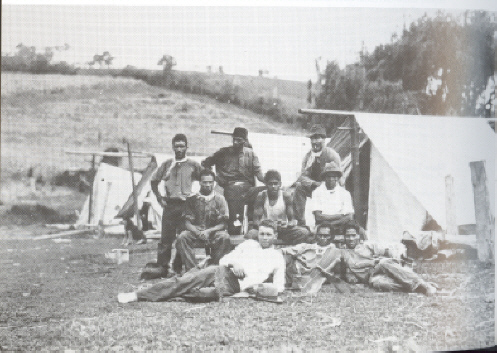| Home Page
Photo Page
Photo Page
Sugar/Sand/Cguard
History of the Police
Aboriginal/Islander
Water/Shipping
Water/Shipping photos
Sporting
Cudgen/Kingscliff in WW1/2
School Photos
Kingscliff Public Library
Contact us
|
|
Aborigines of the Cudgen/Kingscliff Area
Lifestyle of the people:
The lifestyles of the people in the Tweed Valley was rather relaxed, with food and all raw materials for building, hunting, fishing and crafts not to far away. They didn't have to take long journeys or frequently move campsites. This gave the people plenty of leisure time to practice their skills and crafts.
Right: Islanders often lived in tents on the properties where they worked.
Photo courtesy of James Cook University.
Minjunbal is a dialect of Bundjalung.
Within the Minjunbal tribe ranged a number of smaller groups or clans. These groups or clans would have their own campsite and the people from each of the groups would hunt together and share their food.
Some words of the local language are:
Sun-nunga, Children-charjum, Moon-gibbun,
Father-beung, Star-kiomegun, Mother-wudjung,
Fire-wibra, Sister-nunung, Water-koong, Brother-punnam, Ground-chockun, Good-punyara, Wind-buroogin, Bad-chung, Rain-quong or koong, How many (are there?-minyungboo, Stone-boodin, Camp-demmon, Where?-ille?, Sand-yerrung, Where is Tommy?-ille Tommy?, Where are you going?-winge go warlo?,What?-minyung?, There-kille, One-yabbru, Two-bulla, Three-bulla yabrru, Four-bulla bulla
|
 |
|
South Sea Islanders
South Sea Islanders (Kanakas)
How did these hardworking people arrive in this region and what contribution have they played in the Kingscliff area?
The hardworking Kanakas, as they were known, were brought here by black birders (pirate kidnappers). Throughout 1860 to 1890 approximately 50,000 South Sea Islanders arrived through the Queensland Indenture Act. These happy-go-lucky people filled a niche where white labour was not available.
They tended gardens, grew vegetables, planted, cut and cared for the sugar-cane plantations. These selfless people also contributed to the increase in the population of the area for which if their numbers had not been included at the time, many public amenities would not have been built, for example the Cudgen Primary School.
The Islanders, although a separate cultural identity to Aborigines, were denied the same rights as the Aboriginal community (voting and census information amongst other rights). Recognition of their status went unrecorded until the 1960's. Another contentious issue arose in 1917 and again in 1925, was when Education Department Inspectors answered a call by a white minority to separate the black and white children of Cudgen Primary School. This was deemed unnecessary as the black children were as academic and healthy as the rest, and that in some cases the petition could be taken into account against some of the white children. Another problem of acceptance that the black men found disturbing, was the fact that when they volunteered for the World Wars early in the piece, their application of volunteering to serve overseas were revoked. It was not until a couple of years into the war and after, when the black volunteers were truly accepted to fight for their countries soil in the army.
The coloured community was to add their own distinct brand to the area by the sweat off their backs, cheerfulness and their natural sporting abilities. Although many of the Islanders were forced back to their homelands through repatriation, a number remained in the area through their descendants, and forever in the Cudgen Cemetery.
|
|
|


